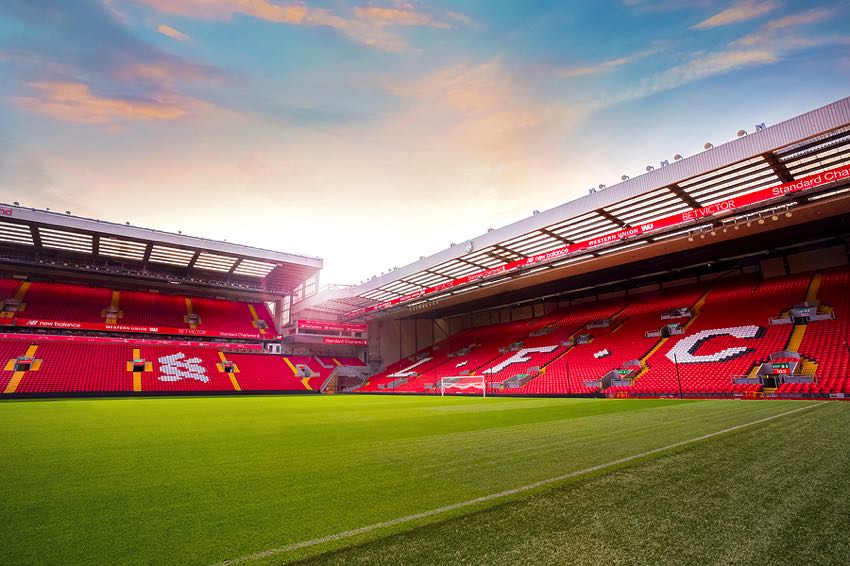
coward_lion, Bigstockphoto
Anfield is unquestionably one of the best known football stadiums in the entire world. The mythology of the Kop is something that has entered Liverpool Football Club’s folklore and the famous European nights it has witnessed has also made it one of the most beloved grounds anywhere.
The sad truth is, however, that the powers that be failed to realise the importance of an improved and improvable stadium. Whilst Manchester United spent the 1990s taking short-term hits – such as Old Trafford’s capacity being reduced to an all-time low of 44,000 – they did so for the purposes of a long-term gain in a vastly increased capacity once all changes were made.
Liverpool’s owners decided to ignore this and carry on doing things the same way that they had always been done. At the end of the 2013-2014 season Old Trafford had a capacity of 75,635 compared to Anfield’s 45,500. That meant a difference in match day revenue of £50.9 million for Liverpool from £108.1 million for Manchester United. Obviously something needed to be done and in December of 2014 work began on the expansion of The Main Stand.
False Starts and New Dawns
By the time the Liverpool hierarchy realised something needed to be done to keep the club in touch with the financial behemoth that Manchester United had become it was already too late. Alex Ferguson’s reign at Old Trafford had catapulted our long-time rivals to within touching distance of the Reds’ long-held superiority in the trophy cabinet. More worrying for those at the top of the Anfield food chain was the realisation that they couldn’t afford to do much about it on their own. They knew that for the club to take a dramatic step forward it would have to be sold to people willing to invest heavily in its future.
This isn’t the time or the place to discuss the treatment of the club at the hands of Tom Hicks and George Gillett. What’s important to note, though, is that they were the people the club’s former Chairman David Moores believed were the right new owners to help Liverpool return to the top. A lot of that was down to their promise to build a new stadium on a site in Stanley Park, with George Gillett announcing that a ‘spade would be in the ground within sixty days or so’.
Not all fans were behind the notion of abandoning Anfield, the club’s home since it was formed in 1892. But pretty much everyone agreed that a new stadium was a necessity to let us regain some ground on the Red Devils and help to increase the amount of money brought in through ticket sale. Obviously the disastrous reign of the cowboys who Moores sold his legacy to meant that no spade entered the ground and no new stadium was ever forthcoming.
Fenway Sports Group
 When the club was bought by John Henry, Tom Werner and Fenway Sports Group in 2010 they promised to explore every available avenue for the expansion of Liverpool’s stadium capacity. The new ground that Hicks and Gillett had promised was soon realised to be something of a white elephant. FSG realised it would cost a huge amount of money to build the new ground for a relatively insignificant increase on capacity and match day revenue. Instead it was chosen to redevelop Anfield, allowing the club to keep hold of its unique history whilst also earning more money on a weekly basis.
When the club was bought by John Henry, Tom Werner and Fenway Sports Group in 2010 they promised to explore every available avenue for the expansion of Liverpool’s stadium capacity. The new ground that Hicks and Gillett had promised was soon realised to be something of a white elephant. FSG realised it would cost a huge amount of money to build the new ground for a relatively insignificant increase on capacity and match day revenue. Instead it was chosen to redevelop Anfield, allowing the club to keep hold of its unique history whilst also earning more money on a weekly basis.
The planned changes were split into two phases, with Phase One seeing a complete overhaul of The Main Stand. Phase Two is far from guaranteed to happen, but if it does then it will see about 5,000 seats added to The Anfield Road end, taking its capacity to around 9,500.
Phase One: The Main Stand

The old Main Stand could house around 12,000 supporters. Although it was the area of the ground that featured the Director’s Box and main section of corporate hospitality it was also arguably the worst part of the stadium to sit in. There were large structure-supporting columns that limited the view of the pitch for large sections of the crowd. Often on a match day you could see lines of seats behind the columns with nobody in them as they were unable to see the match. These have now been completely removed, although a limited number of seats will still have restricted views because of the way the new stand has been built.
The development has increased the stand’s capacity by about 8,500 seats. That takes the capacity of the stadium as a whole to 54,000, making it one of the largest grounds in the Premier League. It has also turned The Main Stand into a truly impressive structure. It is now visible from the city centre and has become part of Liverpool’s already famous skyline.
As well as increasing the capacity the development has also allowed a new home to be created for the Hillsborough Memorial, with the eternal flame now housed in a specially designed colonnade. There is also improved access in general to the entire ground.
One of the biggest differences comes in the form of the new hospitality sections of the newly developed stand. FSG have long believed in the importance of revenue from hospitality and there are a number of brand new sections of it in The Main Stand. The Premier Club and The Dugout are designed to entice the regular match going fan to taking out a hospitality package, whilst the Premium Level and Executive Level packages will appeal predominantly to the very well off or to businesses.
The alternations to The Main Stand and the surrounding area have cost in the region of £100 million. What it has created is the biggest single stand in all of Europe, completely dwarfing the Kop in size. It is an incredibly impressive structure.
Phase Two: The Anfield Road
As things currently stand the club has outline planning permission in place to expand the Anfield Road end of the ground by around 5,000 seats. It is unclear exactly what form this expansion will take, largely because FSG have been decidedly cagey about whether it will take place at all.
The reality that FSG have acknowledged is that a development of the Anfield Road will see very little return on investment. It will cost around £50 million to make the changes but they will be unable to install their much loved hospitality seating, meaning that all of the new seats will simply go on general sale. Whilst this might please supporters who struggle to get into the ground, it doesn’t help those responsible for seeing Liverpool’s revenue increase.
The expansion would take Liverpool’s capacity up to around 59,000, but a £150 million investment for an extra 14,000 seats, give or take, doesn’t make huge financial sense. Whatever happens, the future will almost certainly involve the owners waiting to see how The Main Stand’s redevelopment works out and trying to find if they can find a naming sponsor for it. After that all due consideration will be given to the Anfield Road end of the ground.